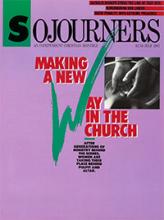1984 is three years past, and the Brave New World is just 20 minutes into the future. That's where the computer-run and video-tranced world of ABC-TV's "Max Headroom" is located. For the uninitiated, the premise of the "Headroom" show is easy to summarize and almost impossible to explain.
Let's say it's a classic buddy picture, like Butch and Sundance. The buddies are a youngish TV reporter (Edison Carter) and his computer-generated, artificially intelligent clone (the titular hero). But the two-dimensional Max has more wit, personality, and life than his flesh-and-blood prototype, Edison Carter. Max Headroom, a literal talking head, has evolved from "a system to a personality."
Max resides in the computer system of TV Network 23 in a world where television sets no longer have "off switches and ratings are taken every two minutes. All the TV screens are two-way. Those who control "the system" can "access" everyone, and the masses of people have no access at all. It's a world controlled by a tiny handful of mega-corporations with "more power than any single government."
It's a post-industrial world dominated by a soaring and sanitized city of office and apartment towers, for those with access to the information economy. Down below lies a South Bronx-type moonscape littered with TV screens, where the disinformed huddle like street people around barrel fires. It's our world, exaggerated by 20 minutes or so.
Read the Full Article

